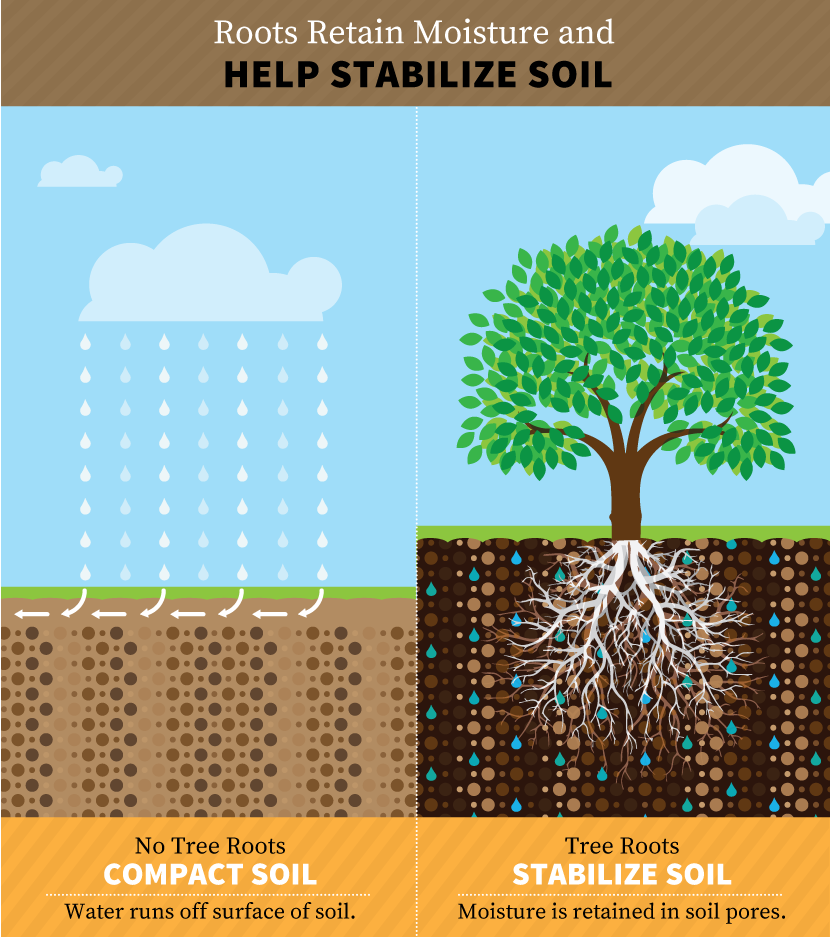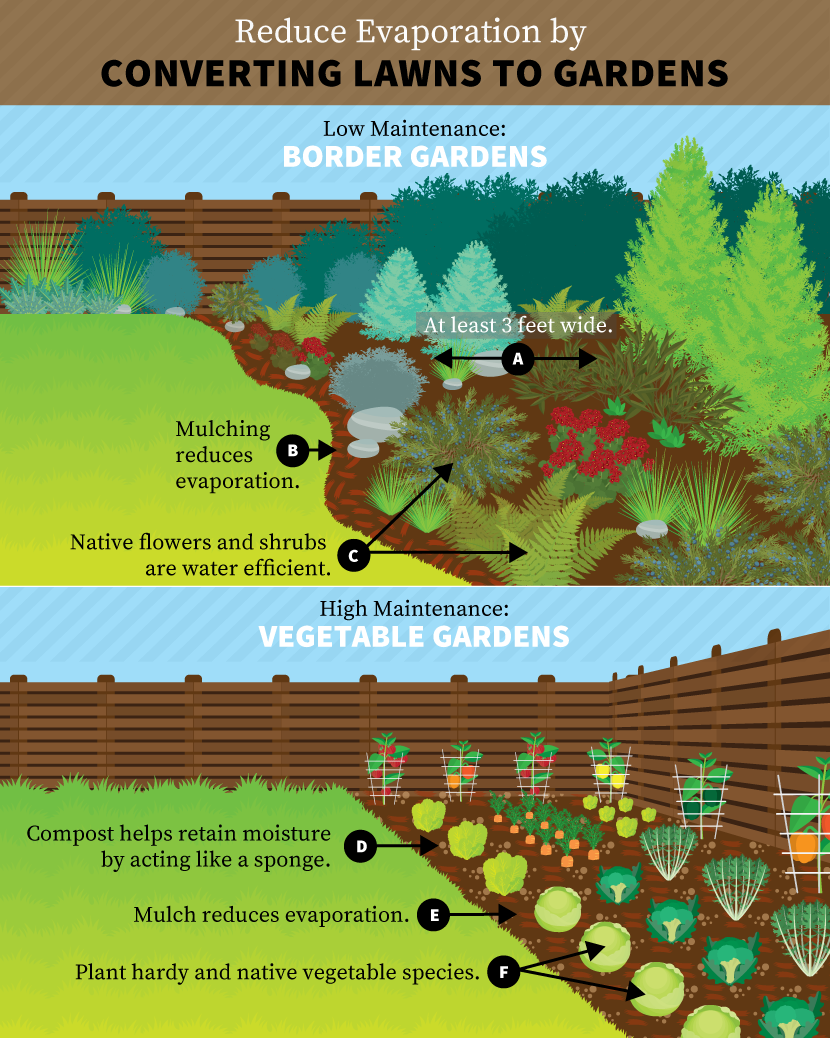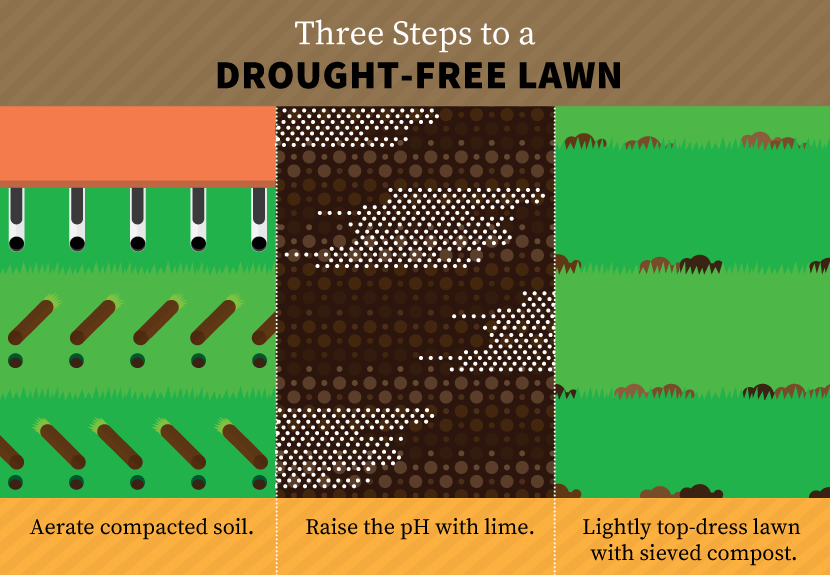Drought-Proofing Your Yard
Climate data indicates that the Earth is experiencing an increase in extreme weather events, including storms and droughts. Scientists predict that this trend will continue to intensify. This article explains how to use holistic design and management to make your property resilient to long periods without rain.
When applied to lawns and gardens, holistic design is all about mimicking nature. By examining how nature has succeeded in moderating extremes between too much water and too little water, we can copy its model.
Undisturbed, natural soils consist of 50 percent particles (e.g., sand, silt, clay, and humus [organic matter]), ~25 percent air, and ~25 percent water. In other words, soil is half particles and half empty space.
In contrast, most lawns and gardens are 70 percent particles and 30 percent empty space because they have been compacted by foot traffic and lawn equipment over many years. Additionally, they may lack humus. Humus is organic matter that has been broken down and that has no cellular structural shape or form. It retains nutrients and moisture, and it is one of the key elements that holds water in soil.

Compacted soils do not readily absorb water during rains, resulting in excessive runoff into streets, streams, and rivers, which adds to flooding dangers. Furthermore, because the water has flowed across the earth’s surface instead of soaking in, less groundwater is stored and available during drier months. Groundwater works like a bank account, with deposits and withdrawals.
In addition, compacted soils lack soil life because they have fewer pockets of air and water. Where soil life is marginal, many types of plants struggle to survive, requiring additional fertilizer, “weed killer,” and irrigation.
From a holistic perspective, drought-proofing a residential property focuses on good water retention and good drainage.
Eliminate Your Lawn
Lawns are notoriously thirsty, and for the most part, they run contrary to the notion of drought-proofing. One of the best things you can do is convert as much lawn as practical to gardens, a wildflower meadow, or a forest. Larger plants, such as trees, have deeper roots than does the grass in your lawn. These roots hold down the soil, thus protecting it from the sun, keeping it less compact, and increasing drainage. Think carefully about how much lawn you use on a regular basis and consider converting the rest.
If you simply stop mowing an area, nature may eventually provide you with a meadow or woodland, depending on your climate zone. But most residential properties are not big enough for a meadow or forest, so the rest of this article will focus on gardens.

Converting Lawns to Garden Spaces
Where I live in New Zealand, we commonly plant a border garden along the perimeter of our yards. These gardens are usually about three feet wide, but from a drought-proofing perspective, the bigger the better. Their key function is to eliminate lawns while providing an attractive, low-maintenance alternative.
Border gardens can be planted with native ground covers, shrubs, trees, ornamental flowers and bushes, or a combination of all these. Functionally, a border garden is like a mini-forest because it has multiple levels of plant growth, higher levels of organic matter than lawns, and un-compacted soils due to little or no regular foot traffic. Once established, a well-mulched border garden should require essentially no watering or weeding.
Another way to eliminate a lawn is to establish annual vegetable gardens. While these require more care and watering than border gardens, some techniques can dramatically reduce the amount of irrigation required to grow abundant backyard veggies.
In a vegetable garden, we strive for a soil composition equal to or better than what we would find in nature. Specifically, this means using soils with 50 percent pore space and even more humus than we would normally find in undisturbed soils.
Incorporating compost in the soil retains moisture by acting like a sponge – and it can be the first thing you do. Compost will also increase the amount of organic matter in your soil.
Maintaining your garden soil at natural levels involves practicing no-till gardening techniques. When you do not turning the soil in your garden, you do not expose the soil to the sun. Furthermore, by adding a layer of mulch on the surface of the soil, you protect the soil surface from evaporation. Proof!
When watering is required, it is best to do it infrequently and deeply. This practice trains the roots of veggie plants to grow downward instead of sideways, which further drought-proofs the plot.

Please note that it is critical that you never step in growing beds. Establish paths or place stepping stones in the garden and stick to them!
Rehabilitate Your Lawn
As thirsty and labor-intensive as they are, lawns do serve a purpose, and most people want at least a small patch of turf. Drought-proofing a lawn can entail a number of different strategies, such as planting drought-resistant varieties of grass or so-called “no-mow” varieties. Here, we will focus on how to improve soil health in the lawn you have right now.
The vast majority of lawns suffer from compaction, low pH, and a lack of organic matter. All these factors reduce soil life. The goal of rehabilitation is to boost soil life by correcting these deficiencies.
The first step is to mechanically aerate the soil. On an autumn day, get out a sturdy garden fork. Working backwards, plunge the fork into the soil as far as you can at an angle of 20 to 30 degrees from the vertical. Push down on the handle, and watch for the surface to puff up as the tines fracture the sod.
As soon as you have finished, apply garden lime (one handful per square yard). After that, do the same with finely sieved compost (five to seven handfuls per square yard).

Aerating, raising the pH, and feeding with compost will make worms and soil microorganisms more active, and the roots of the grass will be able to grow deeper. In the short run, aerating with a fork opens up pore space for both air and water while helping restore natural soil conditions as described above. In the long run, a more neutral pH and increased levels of organic matter will allow soil life to thrive, and when that happens, the soil life itself can maintain a healthy soil composition.
This will occur in your perennial border gardens and no-dig veggie patches, but because lawns receive regular foot traffic, an annual regimen of aeration, liming, and dressing the top with compost will keep the grass healthy and more resistant to long periods without rain.
Embed the article on your site

